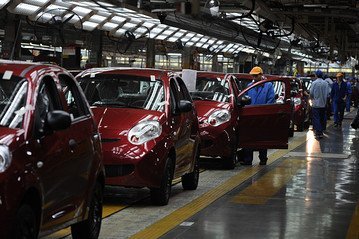Five Predictions for China’s Auto Industry

Chinese consumers, energized with patriotic furor over the disputed islands in the East China Sea, stopped buying Japanese cars for weeks. Australian authorities instructed Great Wall and Chery to recall all of their vehicles when asbestos was founds in engine gaskets. And American presidential politics triggered dog fights over Jeep’s plans to build factories in China and Chinese company’s designs on an American electric car battery maker.
Surely, the roads will be smoother in the Year of the Snake?
Don’t unbuckle your seat belts just yet.
Below are my five predictions for China’s auto industry in the next phase of the Chinese zodiac cycle, which begins Feb. 9:
1. Forget serpents – we’ll look back on 2013 as the year of the electric vehicle. Embarrassed by popular outcry against air pollution the “size of three Californias” that recently blanketed swathes of coastal China, governments in Shanghai and Beijing will mandate electric vehicles for government fleet vehicles and taxis.
Doubt it? How else to explain the recent trajectory of Buffet-owned BYD’s stock? China’s leading electric carmaker has seen the value of its shares more than double in the past 12 months even while BYD’s car sales have remained flat. Investors are waging that despite BYD’s many technical question marks, the orders for EVs are coming. Beijing already offers free license plates and a $19,000 rebate to private EV buyers.
And now that the U.S. Treasury this week formally approved the transfer of A123 Systems into Chinese hands, look for electric battery production to migrate across the Pacific to fill climbing demand.
2. Japanese carmakers will achieve record sales in 2013. High voltage cables had nothing on China-Japan relations in 2012 — and yet Chinese consumers still bought nearly three million Japanese cars and trucks. Look for Japanese brands to quietly regain their appeal among Chinese consumers.
Honda will lead, up 25%, followed by Nissan and Toyota. A significantly weaker yen means it’s impossible-for-Chinese-customers-to-resist prices.
Predicting a Japanese resurgence stands at the opposite end of the spectrum from consensus. It is no secret that the disputed Diaoyu/Senkaku islands remain a potentially explosive flashpoint. But pragmatism will win out. Like Americans, Chinese car buyers often find a way to keep patriotism and purchase behavior separate. When it comes to pricey items like a new car, value for money trumps waving the flag nine times out of 10.
3. China’s astonishing car export growth will draw closer scrutiny and cause new pain. In 2012, China shipped more than a million vehicles overseas — mostly cars priced under $12,000 sent to developing countries. Chinese carmakers will soon be hit by a series of embarrassing recalls in overseas markets as foreign regulators discover what Chinese vehicles are really made of.
In 2012, Australia ordered a complete recall of Chinese vehicles when asbestos was discovered in the engine gaskets. What else is hiding under the hood? Global competitors will be quick to alert authorities to anything suspicious in the Chinese hardware. China car firms, for their part, will begin to pine for their cozy, lenient and flexible home-field advantages.
4. Geely will decide it’s done with Volvo. In 2009, Geely Chairman Li Shufu quipped that acquiring Volvo was like a “Chinese peasant marrying a European princess.” In 2013 the new headline will read: Chinese Peasant Dumps European Queen.
Three years after the Volvo purchase, Geely has absorbed lots of useful technologies while Volvo languishes under suffocating costs. If the Swedish unions insist on keeping Volvo plants in Northern Europe, look for Geely to sell the factories to the ECB, but keep the Volvo brand name.
Of course, given the politics involved, Chairman Li will have some explaining to do. And he will not disappoint: “Hey, you guys fixed Greece, didn’t you? I’m sure you can manage the rescue of a few lethargic factories, too.”
5. An iconic American brand could turn Chinese. How? Simple: Look for Fortune 500 member Shanghai Auto Industry Corp (SAIC) to bid for the Buick brand from General Motors. Such a purchase would formalize what is already fact in the marketplace. In 2012, Chinese accounted for more than three out of four Buicks sold globally. And many of the design elements of the current Buick lineup originated in China.
SAIC aims to be a global player and desperately needs a strong brand to lead the way. Why not just take couple of billion from SAIC’s piggy bank and acquire the Buick brand outright? GM might even feel a sense of relief as it unloads a brand that continues to experience wheel spin in America.
Not so fast, right? American taxpayer cries of betrayal would immediately echo across the nation. Clearly, Buick would not be alive today without Washington’s rescue money in 2009. Would this deal, however logical, get stopped in its tracks? Congress and the U.S. administration would come under serious voter pressure to team up and block it.
Nouvelles connexes


